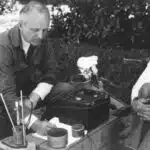The health of soil is crucial for the success of any agricultural endeavor. Soil scientists have long recognized the importance of nitrogen in the growth and development of plants. Nitrogen is an essential nutrient for plant growth and development, and it plays a key role in photosynthesis, root development, and overall plant health. However, nitrogen levels in soil can fluctuate depending on factors such as weather conditions, soil type, crop rotation practices, and fertilizer application.
Adding nitrogen to soil is a delicate process that requires careful consideration of several factors. The process involves selecting the appropriate source of nitrogen fertilizers and applying them at the right time and rate to ensure optimal plant growth. Additionally, adding nitrogen to soil should be done in a way that minimizes environmental impact while maximizing crop yield. This article aims to provide insights into how to add nitrogen to soil in any season using proven techniques that are effective at improving soil fertility while minimizing negative impacts on the environment.
Understanding The Importance Of Nitrogen For Soil Health
While it is true that soil naturally contains nitrogen, it is often not enough to support the growth of plants. Nitrogen is an essential macronutrient for plant growth and development as it plays a vital role in the production of chlorophyll, which is responsible for photosynthesis. Without adequate nitrogen, plants may become stunted or have yellowing leaves due to a lack of chlorophyll.
The nitrogen cycle is a complex process that involves the conversion of atmospheric nitrogen into organic compounds that can be used by plants. Nitrogen fixation techniques such as crop rotation, cover cropping, and intercropping are commonly used to increase the amount of nitrogen in the soil. These practices involve growing specific crops in a particular order or simultaneously with other crops to enhance soil fertility.
As soil scientists continue to study ways to improve soil health, they recognize the crucial role that nitrogen plays in sustaining plant life. By understanding the importance of nitrogen and implementing effective strategies for increasing its availability in the soil, we can ensure that our crops thrive and provide nourishment for ourselves as well as others. Moving forward, assessing soil nitrogen levels will be essential in ensuring optimal plant growth and productivity.
Assessing Soil Nitrogen Levels
To ensure adequate nitrogen levels in soil, it is important to regularly assess the amount of nitrogen present. Soil testing labs offer a variety of measuring techniques, including chemical analysis and plant tissue analysis. Chemical analysis involves extracting soil samples and analyzing them for total nitrogen content using methods such as Kjeldahl digestion or Dumas combustion. Plant tissue analysis involves collecting plant samples and analyzing them for nutrient content. This type of analysis can provide insight into both soil fertility and plant health.
Interpreting results from soil tests requires careful consideration of various factors, including crop requirements, soil texture, organic matter content, and previous fertilizer applications. It is important to use testing labs that provide accurate results and have experience interpreting them. In general, a target range for soil nitrogen levels would be between 50-100 pounds per acre for most crops.
To ensure optimal growth and yield of plants, it is crucial to monitor soil nitrogen levels throughout the growing season. Regular testing helps identify deficiencies or excesses that may hinder plant growth or contribute to environmental pollution. Interpreting test results can also help determine appropriate fertilizer application rates and timing, leading to more efficient use of resources while minimizing negative impacts on the environment.
- Measuring techniques: Chemical analysis (Kjeldahl digestion or Dumas combustion) and plant tissue analysis are two commonly used techniques.
- Factors affecting interpretation: Crop requirements, soil texture, organic matter content, previous fertilizer applications.
- Target range for nitrogen levels: Aim for 50-100 pounds per acre for most crops.
- Importance of regular monitoring: Helps identify deficiencies/excesses hindering growth/yield; determines appropriate fertilizer application rates/timing.
- Benefits of interpreting results: More efficient resource use; minimized negative environmental impacts.
Moving forward into identifying nitrogen deficiencies in plants, it is important to note that this step requires close attention to plant appearance and growth characteristics in addition to soil testing.
Identifying Nitrogen Deficiencies In Plants
- Nitrogen is an essential macronutrient for plant growth and development, and plants can suffer from a nitrogen deficiency if there is an imbalance of nitrogen levels in the soil.
- Common symptoms of nitrogen deficiency include yellowing of the leaves, stunted growth, and lower yields.
- To assess nitrogen levels, soil samples should be taken from different depths of the soil, and tested for their nitrogen content.
- Nitrogen can be added to the soil through organic and inorganic sources – for instance, compost and synthetic fertilizers, respectively.
- Organic sources, such as compost, are preferred because they release nitrogen slowly over time, and are less likely to cause an imbalance in the soil’s nutrients.
- Lastly, the amount of nitrogen added and the timing of application should be based on the specific needs of the crop and the soil, and can vary between seasons.
Symptoms Of Nitrogen Deficiency
As a soil scientist, it is disheartening to observe nitrogen-deficient plants in a garden or farm. Nitrogen is an essential nutrient for plant growth, and its deficiency can significantly impact crop yields and quality. The symptoms of nitrogen deficiency are usually visible on the leaves of plants. Leaves may start turning yellow from the tips and gradually move towards the base. Additionally, leaves may become thin and brittle, with stunted growth.
The effects of nitrogen deficiency can be mitigated by promptly addressing the cause of inadequate nitrogen supply. There are several remedies that gardeners and farmers can employ to add nitrogen to soil in any season. One effective way is through the use of organic fertilizers such as compost or manure. These fertilizers release nutrients slowly over time, ensuring that plants have a steady supply of nitrogen throughout their growth cycle. Other options include using synthetic fertilizers or planting legumes that fix atmospheric nitrogen into the soil.
It is crucial for gardeners and farmers to regularly monitor their plants for signs of nutrient deficiencies such as nitrogen deficiency. By doing so, they can take proactive steps to address any issues before they escalate into significant problems affecting crop productivity and quality. With proper care and attention, it is possible to create a healthy and nutrient-rich soil environment that supports vibrant plant growth all year round.
Assessing Nitrogen Levels
Assessing nitrogen levels in soil is a critical aspect of maintaining plant health and productivity. Nitrogen is an essential nutrient that plants require for various physiological processes such as photosynthesis, growth, and reproduction. Soil scientists use various measuring techniques to determine the levels of available nitrogen in soils. One common method involves collecting soil samples from different depths and analyzing them for total nitrogen using laboratory techniques such as Kjeldahl digestion or combustion analysis. Alternatively, portable field kits can be used to measure nitrate levels in soil water extracts.
Measuring nitrogen levels is not only important for identifying deficiencies but also for understanding the nitrogen cycle in soils. Nitrogen is a dynamic element that undergoes several transformations in the soil environment. It can exist in various forms such as organic matter, ammonium, nitrate, and atmospheric gas. The cycling of nitrogen involves complex biological and chemical processes that affect its availability to plants. By assessing nitrogen levels, soil scientists can gain insights into the factors that influence the cycling of this element in soils.
In conclusion, assessing nitrogen levels is crucial for maintaining healthy plant growth and productivity. Soil scientists use various measuring techniques to determine available nitrogen levels in soils, which provide insights into the cycling of this element in soils. By understanding these cycles, farmers and gardeners can make informed decisions about fertilization practices to optimize crop yields while minimizing environmental impacts.
Nitrogen Sources
Identifying nitrogen deficiencies is crucial to maintain plant health and productivity. However, before discussing how to identify nitrogen deficiencies in plants, it is necessary to understand the different sources of nitrogen available in soils. Nitrogen is obtained by plants through two primary sources: atmospheric nitrogen fixation and soil organic matter decomposition.
Nitrogen fixation is the process by which atmospheric nitrogen gas (N2) is converted into a biologically available form such as ammonia (NH3) or nitrate (NO3-). This conversion occurs through symbiotic relationships between certain types of bacteria and leguminous plants or through non-symbiotic bacteria found in soils. Nitrogen fixation contributes significantly to the availability of nitrogen in soils, especially in areas where organic matter levels are low. Crop rotation with leguminous crops can improve soil fertility because they can fix atmospheric nitrogen and add it to the soil.
Soil organic matter decomposition is another source of nitrogen for plants. Organic matter contains various forms of nitrogen, such as amino acids, proteins, and other compounds that break down into ammonium and eventually nitrate. Soil microorganisms play a vital role in this process by decomposing organic matter and releasing nutrients back into the soil. Understanding these two primary sources of nitrogen can help farmers and gardeners make informed decisions about fertilization practices that optimize plant growth while minimizing environmental impacts.
Choosing The Right Nitrogen Fertilizer
As we have learned from the previous section, plant nitrogen deficiencies are a common problem that gardeners and farmers encounter. In fact, according to a study conducted by the Food and Agriculture Organization (FAO), nitrogen deficiency is the most limiting factor for crop productivity worldwide. Therefore, it is crucial to address this issue by adding nitrogen to soil in any season.
To add nitrogen to soil, there are various types of nitrogen fertilizers that you can choose from. The three main types are organic, inorganic, and slow-release fertilizers. Organic fertilizers are made from natural sources like animal manure or compost, while inorganic fertilizers are synthetically produced. Slow-release fertilizers release nutrients gradually over time, providing more consistent nourishment for plants.
When applying nitrogen fertilizer to soil, it is important to follow proper techniques to ensure optimal results. One technique is broadcasting, where fertilizer is spread evenly across the entire area of soil being treated. Another technique is banding, where fertilizer is applied in a concentrated band either below or above the seed line. It’s also important to consider factors such as weather conditions and plant needs when determining the amount and frequency of application.
Moving forward, it’s important to consider whether organic or inorganic nitrogen sources are best for your specific situation. The next section will explore the differences between these two options and provide insight on which one may be more suitable for your needs as a gardener or farmer.
Organic Vs. Inorganic Nitrogen Sources
Organic nitrogen benefits the soil and crops in several ways. It slowly releases nitrogen into the soil, providing a steady supply of nutrients over time. This is because organic matter needs to be broken down by microorganisms before its nutrients become available to plants. Organic nitrogen sources also improve soil health by promoting beneficial microbial activity, increasing water retention, and reducing erosion.
On the other hand, inorganic nitrogen has some drawbacks that need to be considered. While it provides an immediate boost of nutrients to plants, it can also leach out of the soil quickly and harm aquatic ecosystems if not managed properly. Additionally, overuse of inorganic fertilizers can lead to nutrient imbalances in the soil, which can negatively impact plant growth and yield.
To make informed decisions about how to add nitrogen to your soil, it’s important to understand both the benefits of organic sources and drawbacks of inorganic sources. When choosing between these options, consider your specific goals for crop production and environmental sustainability.
- Organic nitrogen sources:
- Compost
- Provides additional micronutrients
- Increases water holding capacity
- Cover crops
- Adds organic matter when tilled or mowed down
- Reduces weed pressure through competition
By incorporating organic nitrogen sources into your soil management plan, you can improve overall soil health while also providing necessary nutrients for crop growth.
Transitioning into calculating nitrogen application rates: With an understanding of different types of nitrogen sources available, the next step is determining how much should be applied for optimal plant growth.
Calculating Nitrogen Application Rates
Nitrogen is an essential nutrient for plant growth, and it is crucial to maintain adequate nitrogen levels in the soil to ensure high crop yields. Nitrogen application techniques vary based on the season and the specific needs of the crops. Applying nitrogen fertilizer in any season requires a thorough understanding of soil nutrient management strategies.
To calculate nitrogen application rates, it is necessary to determine the amount of nitrogen required by the crops and the current soil nitrogen levels. The amount of nitrogen needed by crops varies depending on the type of crop, growth stage, and yield goal. Soil testing provides an accurate measure of soil nitrogen levels, which helps determine how much additional nitrogen should be applied. A simple formula for calculating nitrogen application rates is:
Nitrogen Required (lb/acre) = (Crop Yield Goal – Expected Soil Nitrogen Release) / Nitrogen Use Efficiency
The table below shows typical values for expected soil nitrogen release and nitrogen use efficiency for various crops.
| Crop | Expected Soil Nitrogen Release (lb/acre) | Nitrogen Use Efficiency |
|---|---|---|
| Corn | 50 | 0.8 |
| Wheat | 30 | 0.5 |
| Soybean | 20 | 0.7 |
By using this formula and adjusting for different crop types and yield goals, farmers can accurately calculate the amount of fertilizer needed to supplement soil nutrient levels with additional nitrogen.
Applying proper amounts of nitrogen fertilizers at different times during the growing season can help ensure optimal crop growth and yield. In springtime, when plants are actively growing, applying a portion of total fertilizer requirements can be beneficial as it provides plants with ample nutrients they require during peak growth periods. To avoid over-fertilizing or under-fertilizing crops with excessive or insufficient amounts of fertilizer, farmers should monitor plant health closely throughout the growing season and adjust their fertilization program accordingly. Properly managed nitrogen applications can improve crop yields, reduce losses, and increase profits.
Applying Nitrogen Fertilizer In Spring
Did you know that spring is the best time to apply nitrogen fertilizer to your soil? According to recent studies, applying nitrogen in early spring can increase crop yields by up to 20%. This is because plants require nitrogen for growth and development, and spring is when they need it the most.
Benefits of early application:
- Improves soil fertility: Nitrogen helps improve the overall health of soil by increasing microbial activity and promoting nutrient availability.
- Enhances plant growth: Nitrogen is essential for leafy green growth, which is important for many crops such as lettuce, spinach, and cabbage.
- Increases crop yields: Applying nitrogen fertilizer in spring can significantly increase crop yields due to improved plant growth and health.
However, there are precautions you should take when fertilizing in spring. Excessive nitrogen application can lead to leaching, where nutrients are washed away by rains or irrigation. To prevent this from happening, it’s important to follow recommended rates based on your soil test results. Additionally, consider using slow-release fertilizers that release nutrients over time instead of all at once.
In the next section, we will discuss how to apply nitrogen fertilizer in summer for optimal plant growth and yield. By understanding the benefits and precautions of spring fertilization, you’ll be able to make informed decisions about your soil fertility management throughout the growing season.
Applying Nitrogen Fertilizer In Summer
Summer is a great time to apply nitrogen fertilizer to soil. Nitrogen plays a vital role in plant growth and development, especially during the peak growing season. It is important to understand how to properly apply nitrogen fertilizer during summer months to maximize its benefits and avoid potential dangers.
One option for adding nitrogen to soil in the summer is through slow release nitrogen fertilizers. These types of fertilizers are designed to provide a gradual release of nitrogen over an extended period, reducing the risk of leaching or volatilization. The benefits of slow release nitrogen include improved plant growth, increased root development, and reduced environmental impacts compared to traditional quick-release fertilizers.
However, it is crucial to take precautions when applying nitrogen fertilizer during the summer. High temperatures and excessive rain can increase the risk of nitrogen loss through leaching or volatilization. It is important to follow recommended application rates and timing based on soil test results, as well as avoiding applications before heavy rainfall events or during periods of extreme heat. Proper management practices will ensure that applied nitrogen remains available for plant uptake and does not negatively impact the environment.
Transition: While summer can be an ideal time for applying nitrogen fertilizer, fall also presents unique opportunities for optimizing nutrient availability in soil. Let’s explore the advantages and considerations for applying nitrogen fertilizer during fall months.
Applying Nitrogen Fertilizer In Fall
As the summer heat fades away, leaves start changing colors and fall arrives. The crisp air and shorter days indicate that it’s time to shift our focus towards preparing soil for the fall application of nitrogen fertilizer. It is essential to take appropriate measures as applying nitrogen at the wrong time or in improper amounts can lead to environmental pollution and harm plant growth.
Fall application of nitrogen fertilizer plays a vital role in enhancing soil fertility during winter dormancy. Soil conditions in autumn are conducive to nutrient uptake as plants prepare for winter rest, making it an ideal season to apply nitrogen fertilizer. Applying nitrogen at this time helps replenish depleted nutrients and improves soil quality, which leads to better crop yield in the next growing season.
To ensure best practices when applying nitrogen fertilizer in fall, it is necessary to conduct a soil test first. This provides critical information on existing nutrient levels and pH balance that helps determine the required amount of fertilizer needed for optimal results. Additionally, it is essential to follow recommended application rates based on plant requirements and avoid over-application as this can cause runoff into groundwater sources or contribute to environmental pollution.
As we move into winter, understanding how to apply nitrogen fertilizer becomes even more important. Despite the challenges that come with colder weather, there are still steps you can take to maintain soil health throughout this crucial period.
Applying Nitrogen Fertilizer In Winter
When choosing a fertilizer to apply in winter, one should select a product that contains nitrogen as its primary nutrient and consider the type of soil in which it will be applied. Applying nitrogen fertilizer in winter should be done carefully due to the slow rate of nutrient release in cold soil. Before applying nitrogen fertilizer in winter, soil should be tested for pH and nutrient levels to ensure an appropriate application rate. Additionally, soil should be tilled to a depth of at least six inches to ensure uniform distribution of fertilizer throughout the soil. Applying nitrogen fertilizer in winter should be done evenly across the field, taking into account topography, soil moisture levels, and crop rotation. Finally, it is important to monitor soil nitrogen levels over the course of the season to ensure optimal nutrient availability for the crop.
Choosing Fertilizer
When choosing fertilizer to add nitrogen to soil, it is important to consider the different types of fertilizers available. The most common types of nitrogen fertilizers include urea, ammonium nitrate, and ammonium sulfate. Urea is a synthetic fertilizer that contains 46% nitrogen and can be applied in any season. Ammonium nitrate is another synthetic fertilizer containing 33% nitrogen, and it is commonly used during the winter months when nitrogen availability in the soil is limited. Lastly, ammonium sulfate is a natural fertilizer that contains 21% nitrogen and can be used in any season.
Another factor to consider when choosing a fertilizer type is the availability of nitrogen in the soil. Nitrogen availability depends on various factors such as temperature, soil pH, and moisture levels. During winter months, soil temperatures are typically low which limits microbial activity necessary for converting organic matter into plant-available forms of nitrogen. Therefore, applying a quick-release form of nitrogen such as ammonium nitrate can provide an immediate source of available nitrogen for plants.
In conclusion, selecting the appropriate type of fertilizer based on its characteristics and considering the availability of nutrients in the soil are critical factors when adding nitrogen to soil during any season. By understanding these factors, gardeners and farmers can select the best option for their specific needs while promoting healthy plant growth and maximizing crop yields.
Applying Fertilizer
Fertilizer application techniques are important considerations when applying nitrogen fertilizer during the winter season. One technique is incorporating the fertilizer into the soil before planting to ensure that it is readily available to plants. Another technique is top-dressing, which involves applying the fertilizer on top of the soil after planting. This method can be effective if done correctly, but caution should be exercised to avoid leaf burn and leaching of nutrients.
Additionally, different crops have varying rates of nitrogen uptake, which should also be considered when applying fertilizers. For example, brassica crops such as broccoli and cauliflower require higher levels of nitrogen compared to root crops like carrots and potatoes. Therefore, it is crucial to select a fertilizer with an appropriate nitrogen ratio for the specific crop being grown.
Overall, ensuring proper fertilizer application techniques and selecting a suitable nitrogen fertilizer ratio for each crop can maximize nutrient uptake during winter months. By doing so, farmers and gardeners can promote healthy plant growth and improve crop yields even in challenging weather conditions.
Soil Preparation
A crucial aspect of applying nitrogen fertilizer during the winter season is soil preparation. Adequate soil moisture and pH levels are essential for optimal nutrient uptake by plants. Therefore, it is essential to ensure that the soil is well-drained and has a pH level within the appropriate range for the crop being grown. Soil testing can help determine the soil’s pH level and nutrient content, allowing farmers and gardeners to make informed decisions about fertilizer application rates.
In addition to soil moisture and pH levels, soil structure also plays a role in nitrogen uptake. Compacted soils can limit root growth, reducing nutrient absorption. Therefore, it is recommended to loosen compacted soils before planting by tilling or using other appropriate techniques such as cover cropping or deep tillage. This will create a more favorable environment for root growth and maximize the benefits of applying nitrogen fertilizers.
Overall, proper soil preparation is critical when applying nitrogen fertilizer during winter months. By ensuring adequate soil moisture, appropriate pH levels, and good soil structure before planting, farmers and gardeners can optimize nutrient uptake by their crops even in challenging weather conditions. These practices can promote healthy plant growth and improve crop yields while contributing to sustainable agriculture practices that benefit society as a whole.
Incorporating Nitrogen Into Soil
Nitrogen is essential in soil to promote healthy plant growth. Incorporating nitrogen into soil can be done effectively in any season through various means. One option is planting nitrogen fixing plants, which have the ability to extract nitrogen from the air and deposit it into the soil. Legumes such as peas, beans, and clover are popular examples of these plants. When these plants are left to decompose in the soil after they die off, they release nitrogen that is then available for other plants to use.
Another effective way to add nitrogen to soil is through cover crop rotation. Cover crops such as rye, oats, and barley can be planted during fallow periods or between growing seasons. These crops not only help prevent erosion and improve soil structure but also contribute organic matter that breaks down over time and adds nutrients like nitrogen back into the soil.
Incorporating nitrogen into soil is essential for maintaining healthy plant growth year-round. Nitrogen fixing plants and cover crop rotation are both effective methods of adding this crucial nutrient to your garden or farm. In the next section, we will discuss how you can avoid nitrogen runoff and leaching while incorporating it into your soil.
Avoiding Nitrogen Runoff And Leaching
Nitrogen is an essential nutrient for plant growth and development. However, excess nitrogen can lead to pollution of the environment through runoff and leaching. Nitrogen pollution can cause serious environmental problems such as eutrophication of water bodies, which results in the depletion of oxygen levels leading to fish kills.
Preventing nitrogen pollution requires the use of best management practices. One way to prevent nitrogen leaching is by using cover crops. Cover crops are planted after harvesting the main crop to protect the soil from erosion and nutrient loss. They also help to absorb excess nitrogen in the soil, preventing it from leaching into groundwater or surface water.
Using cover crops has been proven effective in reducing nitrogen loss from agricultural fields. By planting cover crops, farmers can reduce their reliance on synthetic fertilizers, which are a major source of nitrogen pollution. Cover crops also improve soil health by increasing organic matter content, reducing soil erosion and enhancing soil structure and water retention capacity. Farmers can choose different types of cover crops depending on their specific needs such as legumes or grasses that fix atmospheric nitrogen or deep-rooted plants that scavenge nutrients from deeper soil layers.
To further prevent nitrogen pollution, farmers should monitor soil nitrogen levels regularly. This will help them determine the amount of fertilizer needed for optimal crop growth without causing excessive nutrient buildup in the soil. Soil testing can provide information about available nutrients in the soil, allowing farmers to make informed decisions about fertilization rates and timing. Monitoring soil nitrogen levels is an important step towards sustainable agriculture while protecting our environment from potential pollutants caused by excessive fertilizer use.
Monitoring Soil Nitrogen Levels
As a soil scientist, it is crucial to monitor soil nitrogen levels to ensure that crops are receiving adequate nutrients. Adding nitrogen to the soil can be done in any season, but it is important to measure its effectiveness and adjust application rates accordingly. While nitrogen is essential for plant growth and development, overapplication can lead to runoff and leaching, causing harm to the environment.
To monitor the effectiveness of nitrogen application, soil testing should be conducted regularly throughout the growing season. This will help determine if additional applications are necessary or if adjustments need to be made in the amount of fertilizer used. It is also important to consider other factors that may impact nitrogen availability, such as temperature and moisture levels.
Adjusting application rates based on soil test results can help optimize crop growth while minimizing environmental damage from excess nitrogen use. Additionally, incorporating organic matter into the soil can help improve nutrient retention and reduce nutrient loss through runoff and leaching. As a responsible steward of agricultural land, it is important to carefully manage nitrogen use to maximize crop productivity while minimizing negative impacts on the environment.
Assessing the impact of nitrogen on crop yield requires careful attention to detail and a commitment to sustainable farming practices. By monitoring soil nitrogen levels regularly and adjusting application rates as needed, farmers can optimize crop growth while minimizing environmental risks associated with excess nitrate runoff and leaching. In the next section, we will explore strategies for assessing the impact of nitrogen on crop yield through field trials and data analysis.
Assessing The Impact Of Nitrogen On Crop Yield
The impact of nitrogen on crop yield is a crucial topic in agriculture. Nitrogen is an essential nutrient for plant growth, and its availability in soil can significantly affect the yield potential of crops. However, excessive use of nitrogen fertilizers can lead to environmental pollution and loss of biodiversity. Therefore, it is important to assess the impact of nitrogen on crop yield carefully.
One way to assess the impact of nitrogen on crop yield is by studying its effect on soil microbes. Soil microbes play a vital role in soil fertility and plant growth by decomposing organic matter, fixing nitrogen, and releasing nutrients into the soil. Studies have shown that excess nitrogen application can negatively affect soil microbial populations, leading to reduced soil quality and plant health. Therefore, proper management strategies should be implemented to maintain optimal levels of nitrogen without compromising the microbial ecosystem.
Nitrogen management strategies differ depending on the type of crop being grown. For instance, leguminous crops such as beans and peas can fix atmospheric nitrogen through symbiotic relationships with rhizobia bacteria present in their roots. The use of cover crops, crop rotations, and intercropping techniques can also enhance soil fertility by reducing nutrient leaching while providing additional sources of organic matter. These practices promote sustainable agriculture by maintaining optimal levels of soil nitrogen while minimizing environmental impacts.
As we have seen, assessing the impact of nitrogen on crop yield is critical for sustainable agriculture practices. By considering factors such as soil microbes and implementing appropriate management strategies for different crops, farmers can optimize their yields without harming the environment or compromising long-term soil health. In conclusion, maintaining optimal levels of soil nitrogen requires careful consideration and a holistic approach that prioritizes both crop production and environmental sustainability.
Conclusion: Maintaining Soil Nitrogen For Sustainable Agriculture
Transition: As we have seen in the previous section, nitrogen plays a crucial role in crop yield. However, simply adding more nitrogen to the soil is not always the best solution. It is important to consider long-term effects and environmental impact when managing soil nitrogen.
Adding nitrogen to soil can be done in any season, but it is important to do so responsibly. Here are some ways to add nitrogen without harming the environment:
- Use cover crops: Cover crops such as legumes can fix atmospheric nitrogen and add it to the soil.
- Compost: Adding compost to soil increases its organic matter content, which helps retain nitrogen.
- Rotate crops: Planting different crops each season can help maintain soil health and prevent depletion of nutrients.
It is crucial for farmers and gardeners alike to think beyond short-term gains when managing soil nitrogen. Overuse of fertilizers can lead to leaching of nitrates into water sources, causing harmful effects on both human health and aquatic ecosystems. Similarly, excessive use of synthetic fertilizers contributes significantly to greenhouse gas emissions.
In conclusion, responsible management of soil nitrogen is essential for sustainable agriculture. By incorporating practices such as using cover crops, composting, and crop rotation, we can ensure that our farming practices have minimal negative impact on the environment while maintaining healthy soils for future generations.
Conclusion
The health of soil is paramount to sustainable agriculture, and nitrogen plays a critical role in maintaining it. As soil scientists, we understand the importance of assessing and maintaining soil nitrogen levels throughout the year. By identifying nitrogen deficiencies in plants and choosing the right fertilizer, farmers can ensure that their crops receive adequate nutrition to achieve optimal yields.
When choosing between organic and inorganic nitrogen sources, farmers must consider not only the short-term benefits but also the long-term impacts on soil health. Careful monitoring of soil nitrogen levels can help prevent nutrient runoff and leaching, which can have devastating effects on both crop yield and the environment.
As we strive towards sustainable agriculture practices, it is crucial that we maintain healthy soil through proper management of nitrogen levels. The use of appropriate fertilizers, regular monitoring, and responsible farming practices can help us achieve our goals for a prosperous future. Let us remember that maintaining healthy soils is not just a responsibility but also an opportunity to create a better world for ourselves and generations to come. As Wendell Berry said, “The care of the Earth is our most ancient and most worthy, and after all our most pleasing responsibility.”
Image Credits
- “12 Nitrogen Spectrum” by Image Editor (featured)





























